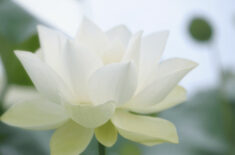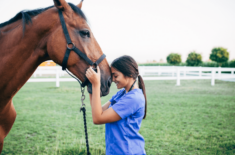The animal connection in yoga is nothing new.
Many of the most well-known poses are named after animals:
- Downward/upward dog (Adho Mukha Svanasana/ Urdhva Mukha Svanasana)
- Cat pose (Marjayasana)
- Cow pose (Bitilasana)
- Crow pose (Bakasana)
- Pigeon pose (Eka Pada Rajakapotasana)
- Fish pose (Matsyasana)
- Eagle pose (Garudasana)
- Cobra pose (Bhujangasana)
The entire objective of yoga is to help us experience union – within ourselves and in the world around us.
Yoga teaches us to be in harmony with all living things.
Yoga isn’t something that we do but rather it’s a way of life.
When practiced in its entirety, the yogic path merges with many life areas.
Doga Can Strengthen Your Connection To Your Pet
Practicing yoga with your fur baby around just got a whole lot more interesting thanks to Doga (dog + yoga).
While this new style or way of practicing asana doesn’t involve your pooch partaking in the poses, it does add creative ways to include your pet into your practice.
Chances are your pet and you are very interconnected and they’re probably extremely perceptive of your moods and emotional state.
When you enter the flow state by mindfully moving your body and breathing rhythmically as we usually do in the vinyasa and ashtanga styles, your increased inner calm transfers to your dog.
Your practicing yoga doesn’t just calm down your nervous system, it also soothes your pup’s nervous system too.
When you become calm your dog will mirror that back to you.
You have an opportunity to create symbiotic unison together, and this can lead to the production of feel-good chemicals like endorphins and even oxytocin.
5 Ways To Practice Doga
1 – Allow your dog to be and act as they will.
This is where mindfulness comes into play – observing what is without judgment or having the need to change it.
In this way, your pup can be one of your biggest mindfulness teachers!
If they start annoying you or interrupting your flow – it’s ok!
Practice the yogic art of self-study and self-observation (Svadhyaya).
Practicing Svadhyaya can help you deepen your practice and sharpen yogic skills that you can take with you off the mat and into everyday moments.
2 – Small to medium-sized dogs can serve as weights.
You can prop them up when you’re in Warrior I (Virabhadrasana I), Crescent lunge, or Chair pose (Utkatasana) for example.
3 – Larger dogs can be bolsters.
Place your legs over your big furry one for a resting pose or place your forehead and arms over them during child’s pose.
4 – Incorporate yoga into your daily walks.
You can incorporate crescent lunges as you walk or take a squat (Malasana) during puppy sniff and pee breaks.
Other poses you can embody are tree pose (Vrkasana), dancer pose (Natarajasana), and mountain pose (Tadasana).
5 – They can be your savasana buddy.
Take final resting pose with your pup by either laying beside them or if they’re small enough placing them on top of you so they can take rest on your belly and the two of you can breathe together.












